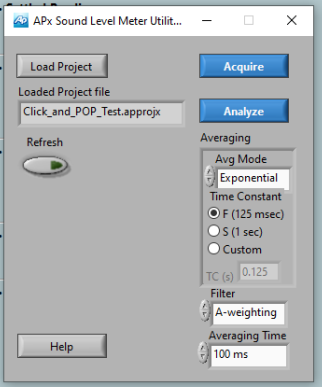SLAAED0 March 2024 TAS2764 , TAS2780 , TAS2781
- 1
- Abstract
- Trademarks
- 1 Introduction
- 2 Measurement Methodology
- 3 Introduction to Noise-gate and Pop in Class-D Amplifiers
- 4 Causes of Pop in TAS27xx family of Class-D Amplifiers
- 5 Click and Pop Using TAS27xx
-
6 Click and Pop Measurement Technique Using
AP v6.0. 2
- 6.1 Measurement Setup
- 6.2 Filter Settings
- 6.3 Data Capture Settings
- 6.4 Auto Range Settings for Pop Measurement
- 6.5 ASI or I2S Configurations for Pop Measurement
- 6.6 APx Sound Level Meter Utility
- 6.7 Data Acquisition
- 6.8 Interpreting Click and Pop Waveforms
- 6.9 Post Processing of AP Waveforms
- 6.10 A-Weighted Click and Pop Numbers
- 6.11 Exporting the A-Weighted Numbers
- 7 Noise-Gate Pop and Measurement Technique Using APx
- 8 Configuring TAS2764 for Improved Click and Pop Noise Performance
- 9 Summary
- 10References
6.6 APx Sound Level Meter Utility
APx Sound Level Meter Utility (Version 6.0.0) is a tool from Audio Precision which is used along with APx500 series analyzer to perform click and pop measurement. This utility takes advantage of the file recording capability of the APx500 software. This method of click and pop measurement is preferred over any other discrete interval measurement methods because,in a discrete measurement method, even at a relatively fast measurement rate of 250 per second, a transient click or pop event can get missed between acquisitions. But in this method, by making a digital recording at a 48kHz sample rate, we can be sure that any audible transients can get captured.
APx Sound Level Meter Utility comes-up with an interface as shown in Figure 6-10. Click the Load Project button in the interface and select the AP project file path which was stored with all required configuration needed for the click and pop measurement.
 Figure 6-10 APx Sound Level Meter Utility
Window
Figure 6-10 APx Sound Level Meter Utility
Window